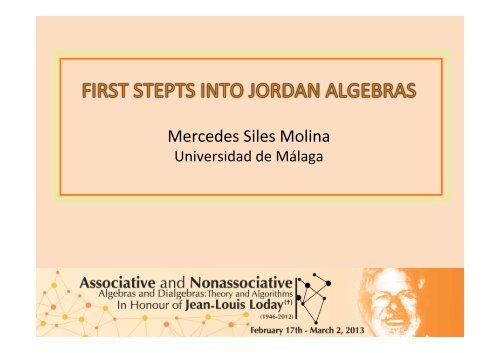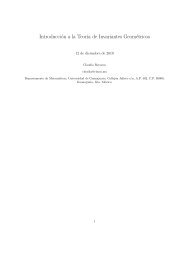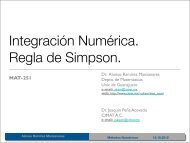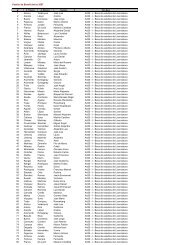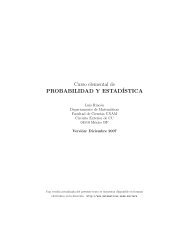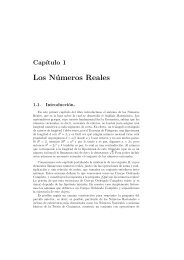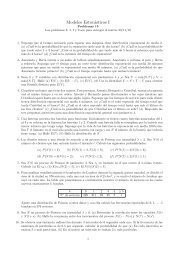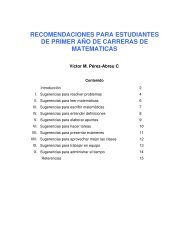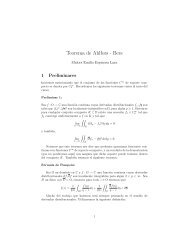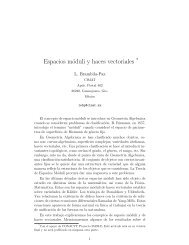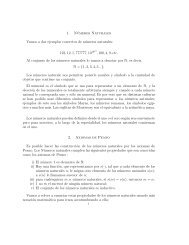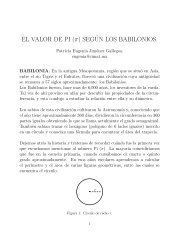L - Cimat
L - Cimat
L - Cimat
Create successful ePaper yourself
Turn your PDF publications into a flip-book with our unique Google optimized e-Paper software.
Mercedes Siles Molina<br />
Universidad de Málaga
Part of this course follows the notes on a course on Jordan algebras<br />
delivered by Prof. Cris=na Draper Fontanals. I’m grateful to her for<br />
sharing her notes.
Bibliography<br />
N. Jacobson, Structure and representa=ons of Jordan<br />
algebras, Colloquium Publica=ons (American Mathema=cal<br />
Society) Vol. 39, 1968.<br />
N. Jacobson, Excep=onal Lie algebras, Lecture Notes in<br />
pure and applied Mathema=cs, 1971.<br />
O. Loos, Jordan pairs, Lecture Notes in Math., vol. 460,<br />
Springer-‐Verlag, Berlin, New York, 1975.<br />
K. McCrimmon, A taste of Jordan algebras, Springer-‐<br />
Verlag, New York, 2003.<br />
R. D. Schafer, An introduc=on to non-‐associa=ve algebras,<br />
Academic Press, 1966.<br />
K. A. Zhevlakov, A. M. Slinko, I.P. Shestakov, A.<br />
I. Shirshov, Rings that are nearly associa=ve, Academic<br />
Press, 1982.<br />
3
F-algebra:<br />
FIRST DEFINITIONS<br />
F field<br />
An F-vector space A<br />
Equipped with a bilinear mul=plica=on A×A→A<br />
(x,y) à xy<br />
AssociaCve F-algebra:<br />
(xy)z = x(yz) for all x,y, z in A<br />
WE WILL CONSIDER NON-‐ASSOCIATIVE ALGEBRAS<br />
4
Examples<br />
Associa=ve F-algebras:<br />
Non associa=ve F-algebras:<br />
5
Jordan algebra:<br />
An F-algebra (J, •) is a Jordan algebra if:<br />
x • y = y • x (Commuta=vity)<br />
(x 2 • y) • x = x 2 • (y • x) (Jordan iden=ty)<br />
Note: x 2 :=x • x<br />
This is the defini=on of a LINEAR Jordan algebra valid for rings of<br />
scalars containing ½. There is a more modern defini=on of quadra=c<br />
Jordan algebra over arbitrary rings of scalars.<br />
6
Examples:<br />
A associa=ve and commuta=ve F-‐algebra<br />
A alterna=ve commuta=ve algebra<br />
A associa=ve F-‐algebra<br />
A + = (A, •)<br />
a • b = 1/2(ab+ba)<br />
Exercise: Show that these are examples of Jordan algebras<br />
7
alterna=ve algebra<br />
8
Suppose A is an algebra<br />
The commutator is [x,y]:= xy - yx<br />
The associator is (x, y, z):= (xy)z - x(yz)<br />
With this nota=on<br />
A is commuta=ve if [x, y]:= 0 for all x, y in A<br />
A is associa=ve if (x, y, z):= 0 for all x, y, z in A<br />
A is alterna=ve if<br />
A is a Jordan algebra if<br />
• It is commuta=ve: [x, y]=0<br />
(x, x, y):= 0<br />
(x, y, y):= 0 for all x, y in A<br />
• It sa=sfies the Jordan iden=ty (x 2 , y, x) = 0<br />
9
Examples<br />
A = Mn (F), A x • y = 1/2 (xy+yx)<br />
+<br />
H(A, t ) = {x in M n (F) | x = x t }<br />
Is not a subalgebra of M n (F)<br />
Is a subalgebra of A + Is Jordan<br />
Is not associa=ve<br />
10
Examples<br />
H(M n (C ) , *) = {x in M n (C ) | x = x * }<br />
Is not a subalgebra of M n (F)<br />
Is a subalgebra of A +<br />
x • y = 1/2 (xy+yx)<br />
Is not associa=ve<br />
Is Jordan<br />
H(A, *) = {x in M n (C ) | x = x * } ≤ A +<br />
x • y = 1/2 (xy+yx)<br />
x* = x t<br />
__<br />
11
Examples<br />
H(M n (C ) , *) = {x in M n (C ) | x = x * }<br />
Is not a subalgebra of M n (F)<br />
Is a subalgebra of A +<br />
(A, *)<br />
associa=ve with<br />
an involu=on<br />
x • y = 1/2 (xy+yx)<br />
x • y = 1/2 (xy+yx)<br />
Is not associa=ve<br />
Is Jordan<br />
H(A, *) = {x in M n (C ) | x = x * } ≤ A +<br />
x* = x t<br />
__<br />
12
ObservaCons:<br />
(A, *)<br />
J ≤ A +<br />
A = H(A, *) + SK(A, *)<br />
Is Jordan Is Lie<br />
Special Jordan algebra<br />
Exceptional Jordan algebra<br />
13
WHEN and WHY did the Jordan algebras appear?<br />
It’s appearance was not to study matrices and symmetric<br />
matrices…<br />
14
1932<br />
15
Matrix Interpreta=on<br />
of Quantum Mechanics<br />
Physical observables represented<br />
Observable opera=ons<br />
λx à mul=plica=on by a real<br />
x+y à addi=on<br />
x n à powers of matrices<br />
Hermi=an matrices (x*= x)<br />
Matrix opera=ons<br />
λx à mul=plica=on by a complex<br />
x+y à addi=on<br />
xy à mul=plica=on of matrices<br />
x* à adjoint operator<br />
xy is observable only if x and y commute (are simultaneously observable)<br />
x* is “invisible”<br />
16
The Jordan program<br />
hkp://en.wikipedia.org/wiki/<br />
File:Jordan,Pascual_1963_Kopenhagen.jpg<br />
Pascual Jordan<br />
(1902-‐1980)<br />
17
The Jordan program<br />
In 1932, Jordan proposed a program to discover a new<br />
algebraic senng for quantum mechanics<br />
Ø To study the intrinsic algebraic proper=es of hermi=an<br />
matrices, without reference to the underlying<br />
(unobservable) matrix algebra.<br />
Ø To capture the algebraic essence of the physical<br />
situa=on by formal algebraic proper=es that seemed<br />
essen=al and physically significant.<br />
Ø To consider abstract systems axioma=zated by these<br />
formal proper=es and see which other new (non-‐matrix)<br />
systems sa=sfied the axioms.<br />
18
The Jordan opera=ons<br />
Which should be the basic observable opera=ons?<br />
How to combine hermi=an matrices to obtain<br />
another hermi=an matrix?<br />
The most natural way is linearizing (forming<br />
polynomials):<br />
product by a real scalar + addi=on + powers<br />
x2 linearization<br />
½(xy+yx) = x • y<br />
The dot product appears<br />
19
Is the dot enough?<br />
Jordan thought that all the products could be expressed using •<br />
More…<br />
x 2 = ½ x • x<br />
x n<br />
That’s why we use<br />
½ in the formula<br />
xyz + zxy (Jordan triple product, obtained linearizing x3 )<br />
x -1<br />
Not xy! (fortunately)<br />
There are opera=ons with hermi=an elements that cannot<br />
be built from the •, e.g.<br />
xyzt + tzyx<br />
Jordan didn’t realise and that was good luck!<br />
20
The Jordan axioms<br />
Which law would they obey?<br />
A property of the hermi=an matrices:<br />
power-‐associa=ve x n • x m = x n+m<br />
The Jordan iden=ty (x 2 • y)• x = x 2 • (y• x)<br />
Another basic property of the hermi=an matrices:<br />
posi=ve-‐definite formally real<br />
The -‐Jordan algebra is called formally real if<br />
x 1 2 +…+ xn 2 = 0 implies x1 = … = x n = 0<br />
In fact, there are some laws sa=sfied by • for hermi=an<br />
elements that cannot be obtained from the Jordan iden=ty.<br />
21
The Jordan axioms<br />
Which law would they obey?<br />
A property of the hermi=an matrices:<br />
power-‐associa=ve x n • x m = x n+m<br />
The Jordan iden=ty (x 2 • y)• x = x 2 • (y• x)<br />
Another basic property of the hermi=an matrices:<br />
posi=ve-‐definite formally real<br />
The -‐Jordan algebra is called formally real if<br />
x 1 2 +…+ xn 2 = 0 implies x1 = … = x n = 0<br />
In fact, there are some laws sa=sfied by • for hermi=an<br />
elements that cannot be obtained from the Jordan iden=ty.<br />
22
The Jordan axioms<br />
The first iden=ty<br />
Which law would<br />
that<br />
they obey?<br />
A property of the hermi=an matrices:<br />
power-‐associa=ve xn • xm = xn+m cannot be built from the<br />
Jordan product was<br />
The Jordan iden=ty (x 2 • y)• x = x 2 • (y• x)<br />
founded in 1963.<br />
Another basic property of the hermi=an matrices:<br />
posi=ve-‐definite formally real<br />
It was needed to wait for<br />
The -‐Jordan algebra is called formally real if<br />
x 1 2 +…+ xn 2 = 0 implies x1 = … = x n = 0<br />
30 years<br />
In fact, there are some laws sa=sfied by • for hermi=an<br />
elements that cannot be obtained from the Jordan iden=ty.<br />
23
There were three basic examples of linear Jordan algebras<br />
known by Jordan<br />
The FIRST example:<br />
Full algebras<br />
A à -associa=ve algebra, A + = (A, •) is a Jordan<br />
algebra<br />
x • y = 1/2 (xy+yx)<br />
It is not necessarily formally real, for instance, for<br />
A = M n (D), n > 1<br />
24
There were three basic examples of linear Jordan algebras<br />
known by Jordan<br />
The SECOND example:<br />
HERMITIAN algebras<br />
(A, *) à - associa=ve algebra with involu=on,<br />
H(A, *) := {x in A | x* = x}<br />
is a Jordan algebra x • y = 1/2 (xy+yx)<br />
*: A→A, linear map<br />
(a*)* = a<br />
(ab)*=b*a*<br />
H(A, *) ≤ A+<br />
25
There were three basic examples of linear Jordan algebras<br />
known by Jordan<br />
The SECOND example:<br />
HERMITIAN algebras<br />
(A, *) à - associa=ve algebra with involu=on,<br />
H(A, *) := {x in A | x* = x}<br />
is a Jordan algebra<br />
A parCcular case:<br />
à (D,-) unital associa=ve algebra with involu=on a ā<br />
à A= M n (D) with * the conjugate traspose, that is, if x = (a ij ),<br />
then x*=(ā ji ). H(A,*) = H n (D, -)<br />
If D = R, C or H with their usual involu=ons then Hn (D, -‐) is<br />
formally real.<br />
Exercise<br />
26
There were three basic examples of linear Jordan algebras<br />
known by Jordan<br />
The THIRD example:<br />
SPIN factor<br />
< , > euclidean inner product on n<br />
JSpinn := 1 n<br />
is a formally real Jordan algebra: Jordan spin factor<br />
1 is the unit element<br />
v • w = 1 for all v, w in<br />
n<br />
27
P. Jordan, J. v. Neumann, E. Wigner, On an algebraic<br />
generaliza=on of the quantum mechanical formalism, Annals<br />
of Math. Vol. 35 (1), 29-‐64 (1934).<br />
Theorem<br />
CLASSIFICATION (I)<br />
hkp://www.jstor.org/stable/1968117<br />
Every finite-‐dimensional formally real Jordan algebra is a direct sum<br />
of a finite number of simple ideals.<br />
Every finite-‐dimensional simple formally real Jordan algebra is isomorphic to<br />
one of:<br />
H n (R, -), H n (C, -), H n (H, -), H 3 (O, -) and JSpin n<br />
28
Special and excep=onal Jordan algebras<br />
J à Jordan algebra<br />
J is special if it is isomorphic to a subalgebra of A + ,<br />
for some associa=ve algebra A.<br />
Examples<br />
-<br />
-<br />
-<br />
J is excepConal if it is not special.<br />
H n (R, -‐), H n (C, -‐), H n (H, -‐) are special Jordan algebras.<br />
Jspin n is a special Jordan algebra.<br />
H 3 (O,-‐) seems to be exceptional, is it?<br />
Exercise:<br />
Show that Jspinn is a subalgebra of A + , for A the<br />
associative) Clifford algebra generated by elements<br />
v1 ,…,vn such that v 2<br />
i = 1, vivj + vjvi = 0).<br />
29
Albert’s Theorem<br />
The surprise<br />
The algebra H 3 (O, -‐) is an excep=onal Jordan algebra<br />
of dimension 27.<br />
Now it is called the Albert algebra (as well as some<br />
extensions).<br />
Exercise:<br />
Show it.<br />
30
Jordan’s idea<br />
The end<br />
(Physical end)<br />
Jordan wanted to find a formally real Jordan algebra of infinite<br />
dimension, not special (since for him the (associa=ve) product xy was<br />
not relevant).<br />
His idea when classifying the simple finite-‐dimensional ones was to find<br />
a family of excep=onal formally real Jordan algebras depending on a<br />
parameter, so that they could provide a clue to find one infinite-‐<br />
dimensional formally real Jordan algebras (perhaps by taking some kind<br />
of limit with the parameter).<br />
But with only one example in the list, this list was not of help to find<br />
the excep=onal searched system.<br />
The reality<br />
(1979) Zelmanov proved that such an algebra does not exist. In fact, he<br />
proved that the examples of Jordan algebras in arbitrary dimension are<br />
essen=ally generaliza=ons of this one finite dimensional).<br />
31
Jordan’s idea<br />
The end<br />
(Physical end)<br />
With the only exception of the<br />
Jordan wanted to find a formally real Jordan algebra of infinite<br />
dimension, not special (since for him the (associa=ve) product xy was<br />
not relevant).<br />
Albert algebra, Jordan algebras<br />
His idea when classifying the simplefinite-‐dimensional ones was to find<br />
a family of excep=onal formally real Jordan algebras depending on a<br />
parameter, so that they could provide a clue to find one infinite-‐<br />
dimensional formally real Jordan algebras (perhaps by taking some kind<br />
of limit with the parameter).<br />
But with only one example in the list, this list was not of help to find<br />
the excep=onal searched system.<br />
hide an associative structure:<br />
Its Jordan product comes from<br />
The reality<br />
an associative one!!<br />
(1979) Zelmanov proved that such an algebra does not exist. In fact, he<br />
proved that the examples of Jordan algebras in arbitrary dimension are<br />
essen=ally generaliza=ons of this one finite dimensional).<br />
32
Only in the sense that he has not had capture all the proper=es of<br />
the hermi=an matrices.
IDENTITIES<br />
An idenCty in an algebra A is a polynomial f(x 1 , x 2 ,…, x n ) € F[x 1 , x 2 ,…, x n ]<br />
such that f(a 1 , a 2 ,…, a n ) = 0 for all a 1 , a 2 ,…, a n € A.<br />
Example: xy-yx and (x 2 y)x-x 2 (yx) are iden==es in any Jordan algebra (char<br />
F≠ 2). (Moreover, the variety of Jordan algebras is defined by such iden==es.)<br />
Luiz A. Peresi will speak about<br />
iden==es in free algebras.
IDENTITIES<br />
An idenCty in an algebra A is a polynomial f(x 1 , x 2 ,…, x n ) € F[x 1 , x 2 ,…, x n ]<br />
such that f(a 1 , a 2 ,…, a n ) = 0 for all a 1 , a 2 ,…, a n € A.<br />
Example: xy-yx and (x 2 y)x-x 2 (yx) are iden==es in any Jordan algebra (char<br />
F≠ 2). (Moreover, the variety of Jordan algebras is defined by such iden==es.)<br />
Shirshov and Macdonald’s Theorem<br />
If f(x 1 , x 2 , x 3 ) € F[x 1 , x 2 , x 3 ] is of degree 0 or 1 in x 3 , and is<br />
an iden=ty in every special Jordan algebra with 1, then f<br />
is an iden=ty in every Jordan algebra.<br />
Corollary<br />
Every Jordan algebra generated by two elements is special.<br />
35
IDENTITIES<br />
An idenCty in an algebra A is a polynomial f(x 1 , x 2 ,…, x n ) € F[x 1 , x 2 ,…, x n ]<br />
such that f(a 1 , a 2 ,…, a n ) = 0 for all a 1 , a 2 ,…, a n € A.<br />
Example: xy-yx and (x 2 y)x-x 2 (yx) are iden==es in any Jordan algebra (char<br />
F≠ 2). (Moreover, the variety of Jordan algebras is defined by such iden==es.)<br />
Shirshov and Macdonald’s Theorem<br />
If f(x1 , x2 , x3 ) € F[x1 , x2 , x3 ] is of degree 0 or 1 in x3 , and is<br />
anExercise: iden=ty in every special Jordan algebra with 1, then f<br />
2<br />
is an iden=ty Show in every it. (UJordan x =2Lx -‐ L algebra. x ) 2<br />
Immediate applicaCon: we may reduce to special Jordan algebras to prove<br />
iden==es such as Macdonald’s iden=ty:<br />
36
An s-‐iden=ty<br />
2{xzx}•{y{zy 2 z}x}-2{yzy}•{x{zx 2 z}y} =<br />
={x{z{x{yzy}y}z}x}-{y{z{y{xzx}x}z}y}<br />
This iden=ty is valid in any special Jordan algebra.<br />
4{xzx} • {y{zy 2 z}x} -‐ 4{yzy} • {x{zx 2 z}y}<br />
= xzx(yzy 2 zx + xzy 2 zy) + (yzy 2 zx + xzy 2 zy)xzx -‐ yzy(yzx 2 zy + yzx 2 zx) -‐ (xzx 2 zy + yzx 2 zx)yzy<br />
= xzxyzy 2 zx + xzy 2 zyxzx -‐ yzyxzx 2 zy -‐ yzx 2 zxyzy<br />
= xz(xyzy 2 + y 2 zyx)zx -‐ yz(yxzx 2 + x 2 zxy)zy<br />
= 2{x{z{x{yzy}y}z}x} -‐ 2{y{z{y{xzx}x}z}y}<br />
But not in any Jordan algebra!<br />
That kind of iden==es are called s-‐idenCCes.<br />
Concretely, that one is Glennie’s idenCty G 9 , discovered in 1963.<br />
37
Excep=onality of Albert’s Algebra<br />
It is enough to check that it does not sa=sfy:<br />
2{xzx}•{y{zy 2 z}x}-2{yzy}•{x{zx 2 z}y} = {x{z{x{yzy}y}z}x}-{y{z{y{xzx}x}z}y}<br />
Exercise:<br />
Take u,v,w € O such that (u,v,w) ≠ 0 and check that the<br />
following choice of elements in Albert’s algebra does not<br />
sa=sfy the iden=ty<br />
38
(From McCrimmon’s book)<br />
Jordan’s program<br />
Jordan thought that there were no s-‐iden==es<br />
Jordan’s goal was to capture the algebraic behavior of hermi=an operators in<br />
the Jordan axioms. But Albert’s algebra does not sa=sfies all the algebraic<br />
proper=es of the Copenhagen model. Jordan was wrong in thinking that his<br />
axioms had captured the hermi=an essence – he overlooked some algebraic<br />
proper=es of hermi=an matrices.<br />
First, he missed some algebraic opera=ons which could not be built from the<br />
bullet: the symmetric n-‐tad products {x 1 ,…,x n } := x 1 … x n + x n … x 1 cannot be<br />
expressed in terms of the bullet for n ≥ 4. (Their inclusion in the axioms would<br />
have excluded both Albert’s algebras and spin factors, landing back in<br />
Copenhagen with nothing but hermi=an algebras.)<br />
Secondly, Jordan missed some laws for the bullet which cannot be derived<br />
from the Jordan iden=ty, the s-‐iden==es, which are in fact just the algebraic<br />
iden==es sa=sfied by all hermi=an matrices which are not consequences of<br />
the Jordan axioms.<br />
39
Algebraists become interested...<br />
A big amount of unexpected connec=ons to other branches of<br />
mathema=cs appeared!<br />
Jordan -‐ von Neumann – Wigner’s Theorem was<br />
extended to finite-‐dimensional Jordan algebras over an<br />
arbitrary algebraically closed field of characterisCc ≠ 2:<br />
none new algebra really appeared.
Let A be an F-‐algebra<br />
Some defini=ons<br />
A is unital if there is a unit element 1€A such that 1x = x1 = x for all x.<br />
Any algebra A can be embedded in a unital algebra F1 A=:Â<br />
A subalgebra B of A is an F-vector subspace such that BB B.<br />
An ideal I A is an F-vector subspace such that IA+AI I.<br />
If I A, we may consider the quotient algebra =A/I: all cosets [x]=x+I<br />
with operations α[x]:=[αx], [x]+[y]:=[x+y] and [x][y]:=[xy].<br />
A is simple if it has not proper ideals and AA ≠ 0.<br />
A is semisimple if it is a finite direct sum of simple ideals.<br />
The center Cent(A) = {c € A| c x = x c, c(xy)=(cx)y=x(cy), x, y € A}<br />
It is a ring of scalars, that is, associative and commutative.<br />
If A is unital, A can be considered as an algebra over its center<br />
A is simple-central if it is simple, unital and Cent(A)=F1.<br />
IMPORTANT BUILDING BLOCKS<br />
FOR THE STRUCTURE THEORY<br />
41
Let F be an algebraically closed field, char F ≠ 2.<br />
Let J be a finite-‐dimensional Jordan algebra.<br />
Then:<br />
• There is an unique maximal nilpotent ideal, Rad J. The algebra J is<br />
semisimple iff Rad J=0. The quo=ent J/Rad(J) is semisimple.<br />
• If J is semisimple, it has 1, and its decomposi=on as a direct sum of<br />
simple ideals is unique: the simple summands are precisely the minimal<br />
ideals.<br />
• If J is simple, it is simple-‐central over F.<br />
• J is simple if and only if it is one of this list:<br />
-<br />
-<br />
-<br />
CLASSIFICATION (II)<br />
F, the ground field<br />
JSpin n (F), the spin factor<br />
H n (C), hermitian matrices (=H(C,*), for C a (split)<br />
composition algebra (there are exactly 4) (n=3 if dim C=8))<br />
42
Some details about the list<br />
The spin factor (direct generalization): if is a nondegenerate<br />
symmetric bilinear form in F n , then we define JSpin n (F)=F1 F n as the<br />
Jordan algebra given by:<br />
◊ 1 is the unit element<br />
◊◊ If v,w € F n , v • w:= 1<br />
Exercise: Check that the spin factor is special.<br />
Show that it is simple if n≠ 1.<br />
Concerning the hermitian matrices, which is the coordinate<br />
algebra, the composition algebra? Which are they? (The 4<br />
ones jointly their involutions…)<br />
More about composi=on algebras<br />
43
The n-‐Squares Problem<br />
Everything started by a number Theory problem…<br />
It was known from centuries that the sums of two squares can be composed:<br />
For us, it is enough to think that the module of the product of two complex<br />
numbers is the product of the modules, and apply to z 1 =x 0 +ix 1 and z 2 =y 0 +iy 1 ).<br />
Euler found (in 1748) a formula for the sum of four squares.<br />
And Cayley (in 1845) found another one for sums of eight squares, but there is no<br />
enough place here! (neither for copying nor for remembering, except if we look<br />
for some more conceptual approach to understand these formulae!)<br />
44
Forms adminng composi=on<br />
A composition algebra is a unital F-algebra A (for F an arbitrary field) with a<br />
nondegenerate quadratic form n: A→F admitting composition, that is,<br />
n(xy) = n(x)n(y)<br />
Nondegenerate means that n(x,A)=0 iff x=0, where n is here the polar form.<br />
The existence of an<br />
m-‐squares formula<br />
m=2<br />
m=4<br />
m=8<br />
The existence of an m-‐dimensional<br />
composi=on R-‐algebra<br />
C (complex numbers)<br />
H (quaternions)<br />
O (octonions)<br />
These three algebras are DIVISION algebras, which for<br />
composi=on algebras is equivalent to:<br />
** There are no (≠ 0) isotropic elements (n(x)=0)<br />
and to<br />
** There are no zero-‐divisors (x, y≠ 0 such that xy=0)<br />
45
Recalling H and O<br />
46
Recalling H and O<br />
47
C, H and O are real composi=on algebras, but not all of them.<br />
Anyway, we need composi=on algebras over algebraically closed fields.<br />
Thus we try to build composiCon algebras.<br />
The Cayley-‐Dickson process<br />
Assume that A is an associa=ve composi=on algebra: it is unital and n: A→F is<br />
a nondegenerate norm admitting composition. The standard conjugation given<br />
by ā = n(a,1)1- a verifies<br />
Take 0≠λ, and define in CD(A,λ) = A Au (two formal copies of A) with<br />
the following product and norm:<br />
The obtained algebra is AGAIN a composi=on algebra.<br />
The process is called the Cayley-‐Dickson process.<br />
48
The composi=on algebras<br />
Generalized Hurwitz Theorem<br />
Every composi=on algebra over a field F is isomorphic to one of the<br />
following types:<br />
q F (if char F≠2). It is a field.<br />
q K(µ) := F1+Fv with v 2 =v+µ and 4µ+1≠0. It is commuta=ve and<br />
associa=ve.<br />
q Q(µ, β):= CD(K(µ), β). These are called quaternion algebras. They<br />
are associa=ve but not commuta=ve.<br />
q C(µ, β, γ) := CD(Q(µ , β), γ). These are called Cayley algebras or<br />
octonion algebras. They are not associa=ve (but alterna=ve).<br />
49
The split composi=on algebras<br />
A composi=on algebra is split if it has zero divisors, or equivalently, isotropic<br />
elements. Over algebraically closed fields, every composiCon algebra is split. And<br />
it is not difficult to check that (over any F) there is only one split composi=on<br />
algebra of each dimension 1,2,4,8:<br />
♣ F<br />
♣ K(0). Isomorphic to F⊕F with the exchange involu=on and n(a):=a 2<br />
♣ Q(0,1). Isomorphic to M 2 (F) with involu=on the conjugate transpose<br />
and n(a)=det(a).<br />
♣ C(0,1,1). It is isomorphic to the Zorn matrices<br />
50
CLASSIFICATION (II REVISTED)<br />
The simple finite-‐dimensional Jordan algebras over an algebraically<br />
closed field F (char F ≠ 2) are:<br />
F<br />
JSpin n (F), n ≥2<br />
H n (F), n ≥3<br />
H n (F⊕F) n ≥3<br />
H n (M 2 (F)), n ≥3<br />
H 3 (C(0,1,1))<br />
51
What happens if the characteris=c of the field is 2?<br />
Or simply, if we consider a ring of scalars instead of a field, like Z?
Some important Operators<br />
If x€J, the left and right mutiplication operators:<br />
L x : J → J , L x (y) = xy<br />
R x : J → J , R x (y) = yx<br />
In these terms, J is a Jordan algebra if and only if<br />
L x = R x<br />
[R x2 , R x ]=0<br />
Now take the quadratic operator<br />
U x : J → J , U x (y) = 2x • (x • y) - x 2 • y<br />
That is, U x = 2 L x 2 – Lx2<br />
Note: if J is special (there is a subjacent product xy), then U x (y) = xyx<br />
53
About these and other “natural” operators<br />
The U-operator satisfies the so called Fundamental Formula:<br />
We define the Jordan triple product:<br />
{x, y, z} = 2 (x • (y • z) + (x • y) • z - (x • z) • y)<br />
Note: if J is special (there is a subjacent product xy), then {x, y, z} = xyz + zyx<br />
We have a related operator:<br />
V x,y : J → J , V x,y (z) = {x,y,z}<br />
Which, at the same =me, can be wriken in terms of the U-‐operator:<br />
If U x,y := U x+y – U x – U y , then {x,y,z} = U x,z (y)<br />
54
The quadra=c program<br />
ObjecCve: give a defini=on of Jordan algebra valid also for fields of<br />
charateris=c 2, and for arbitrary rings of scalars, as the integers.<br />
Idea: switch from the Jordan product x• y = ½ (xy+yx)<br />
to the product U x (y) = xyx<br />
Search<br />
A quadratic axiomatization such that:<br />
• Agrees with the usual one over scalars containing ½<br />
• Admittes all basic examples in characteristic 2<br />
• Admittes essentially nothing new in simple algebras<br />
55
(Unital) quadra=c Jordan algebras<br />
McCrimmon, 1967<br />
A unital quadratic Jordan algebra J (over a ring of scalars Φ) is a<br />
Φ-module with<br />
A quadratic map U: J → End Φ (J)<br />
x U x<br />
and a unit element 1 such that the following operator identities hold in all<br />
scalar extensions<br />
This is equivalent to the fact that the linearizations are valid in J.<br />
56
About this connec=on<br />
Kantor : “There are no Jordan algebras, there are only Lie algebras.”<br />
58
About this connec=on<br />
Kantor : “There are no Jordan algebras, there are only Lie algebras.”<br />
K. McCrimmon: “Of course, this can be turned around: nine Cmes<br />
out of ten, when you open up a Lie algebra you find a Jordan<br />
algebra inside which makes it thick.”<br />
59
The deriva=on algebra<br />
A derivaCon of a Jordan algebra J is an endomorphism D of J such that<br />
D(xy) = D(x)y+xD(y). The deriva=ons form a Lie algebra, der(J).<br />
Example: If J=H(A,*) for A associa=ve with involu=on, each<br />
x € A such that x*=-‐x provides the deriva=on ad x= L x -‐ R x €<br />
der(J).<br />
60
The deriva=on algebra<br />
A derivaCon of a Jordan algebra J is an endomorphism D of J such that<br />
D(xy) = D(x)y+xD(y). The deriva=ons form a Lie algebra, der(J).<br />
Example: If J=H(A,*) for A associa=ve with involu=on, each<br />
x € A such that x*=-‐x provides the deriva=on ad x= L x -‐ R x €<br />
der(J).<br />
In fact, Skew(A,*) ≈ ad{x € A| x*=-‐x} = der (J)<br />
Example: If J=Albert algebra, der(J)=F 4 ! now we<br />
check it<br />
61
The deriva=on algebra<br />
A derivaCon of a Jordan algebra J is an endomorphism D of J such that<br />
D(xy) = D(x)y+xD(y). The deriva=ons form a Lie algebra, der(J).<br />
Example: If J=H(A,*) for A associa=ve with involu=on, each<br />
x € A such that x*=-‐x provides the deriva=on ad x= L x -‐ R x €<br />
der(J).<br />
In fact, Skew(A,*) ≈ ad{x € A| x*=-‐x} = der (J)<br />
Example: If J=Albert algebra, der(J)=F 4 !<br />
The exceptional Lie algebras are related to<br />
the exceptional Jordan algebras<br />
now we<br />
check it<br />
62
Some deriva=ons<br />
In (x,y,x 2 )=0, replace x by x+λz:<br />
Now replace x by x+λw:<br />
Rewrite:<br />
Interchange x and y and subtract:<br />
Note that D € End(J) is a deriva=on iff [R x ,D]= R D(x)<br />
63
Some deriva=ons<br />
In (x,y,x 2 )=0, replace x by x+λz:<br />
Now replace x by x+λw:<br />
Rewrite:<br />
Interchange x and y and subtract:<br />
Note that D € End(J) is a deriva=on iff [R x ,D]= R D(x) , hence<br />
[R x ,R y ] € Der(J)<br />
64
Some deriva=ons<br />
In (x,y,x 2 )=0, replace x by x+λz:<br />
Now replace x by x+λw:<br />
Rewrite:<br />
Interchange x and y and subtract:<br />
Note that D € End(J) is a deriva=on iff [D,R x ]= R D(x) , hence<br />
[R x ,R y ] € Der(J), moreover,<br />
{Σ[R xi ,R yi ] |x i ,y i € J}=[R J ,R J ] is a Lie subalgebra of Der (J).<br />
65
Albert algebra<br />
An arbitrary element in the Albert algebra, say J, is, for α 1 , α 2 , α 3 € F<br />
and a,b,c € C:<br />
With the mul=plica=on table summarized as follows:<br />
66
for<br />
More proper=es of the Albert algebra<br />
Every element x € J as above verifies a cubic equa=on<br />
x 3 -‐ T(x) x 2 + Q(x) x-‐ N(x)1 = 0<br />
T(x) = α 1 + α 2 + α 3<br />
Q(x) = α 1 α 2 + α 2 α 3 + α 3 α 1 -‐ n(a) -‐ n(b) -‐ n(c)<br />
N(x) = α 1 α 2 α 3 -‐ α 1 n(α) -‐ α 2 n(b) -‐ α 3 n(c) + t(abc)<br />
As 1=e 1 +e 2 +e 3 is a decomposi=on into orthogonal idempotents, we have the<br />
generalized Peirce decomposi=on:<br />
J = J 11 + J 22 + J 33 + J 23 + J 13 + J 12<br />
< , >: J × J → F, = tr R xy is a trace form,<br />
< , , >: J × J × J →J, = is trilinear.<br />
J ii = Fe i<br />
J ij = {a (k) |a € C} = C (k)<br />
Exercise: Let d €End J.<br />
Show that d is a derivaCon iff d leaves both < , > and<br />
< , , > invariant<br />
67
Der(Albert algebra)= f 4<br />
Jordan algebras<br />
Lie algebras<br />
DerivaCon algebras of Jordan algebras<br />
provides models for Lie algebras<br />
DerivaCon algebras of excepConal Jordan algebras<br />
provides models for excepConal Lie algebras<br />
68
J. E. Humphreys, Introduc=on to Lie algebras and<br />
representa=on theory, Springer-‐Verlag, New York,Heidelberg,<br />
Berlin 1972.<br />
ClassificaCon of irreducible root systems by using Dynkin diagrams<br />
69
PROOF:<br />
First step: dim Der(J)=52<br />
Der(Albert algebra)= f 4<br />
D 0 := {d €Der(J) | d(e i )=0 for all i} ≅ so(C,n) (≅d 4 , simple dim 28)<br />
If U€ so(C,n) , D U :J → J given by D U (e i ):=0, D U (a (i) ) := U i (a) (i) is a<br />
deriva=on, for U 1 = SUS -‐1 , U 2 =U’ and U 3 =U’’. These endomorphisms<br />
are given by the triality: U(xy)=U’(x)y+xU’’(y) and S(a)=ā denotes the<br />
conjuga=on in C.<br />
Di := {[Ra(i) , Rej-‐ek ]| a€C} ( Der(C,n)); (i,j,k cyclic permuta=on of<br />
1,2,3) (dim 8, since ≅ C as vector space, as {[R a(i) , R ej-‐ek ](e j )= -‐1/2a(i) )<br />
Now check that Der (J)= D 0 + D 1 + D 2 + D 3 (for use that de i € C (j) +C (k)<br />
using the generalized Peirce decomposi=on) and that the sum is direct.<br />
70
f 4 is the algebra of deriva=ons of the<br />
Second step: Der(J) is simple<br />
Albert algebra (bis)<br />
Computa=ons show that [D i , D i ] D 0 and [D i , D j ] D k (i,j,k dis=nct)<br />
Lemma: A fin-‐dim arbitrary algebra A = S + I, dim S > dim I, S simple, SI=I IS.<br />
Then every proper ideal of A is contained in I.<br />
Finally if B J, B D 1 + D 2 + D 3 . Take d=d 1 +d 2 +d 3 € B. Fix i, there exists<br />
b € C with d i =[R b(i),R ej-‐ek ]. Thus [d i , [R a(i),R ej-‐ek ]](c(i) )=(-‐n(b,c)a+n(a,c)b) (i)<br />
=0, since [d i , [R a(i),R ej-‐ek ]] €D 0 (D 1 + D 2 + D 3) =0, so n(a,c)b=n(b,c)a for<br />
all a,c so that b=0.<br />
Corollary: Der J=[R J , R J ]=Inder J.<br />
Proof: [R J , R J ] is an ideal of Der J, which is simple.<br />
71
The structure algebras<br />
The structure algebra is the Lie algebra str(J):= der(J) + R J<br />
The inner structure algebra is the Lie algebra Instr(J):= Inder(J) + R J<br />
Example: If J=H(A,*) for A associa=ve with involu=on, then str(J)=A -‐<br />
Example: If J=Albert algebra, str(J)=F+E6 !<br />
now we<br />
check it<br />
The exceptional Lie algebras are related to<br />
the exceptional Jordan algebras<br />
72
PROOF:<br />
Str(Albert alg)= e 6 (+center)<br />
First step: dim R J0 +[R J , R J ]=78<br />
Direct sum as 1 € J<br />
Second step: it is simple<br />
If B is an ideal of RJ0 +[RJ , RJ ], by lemma, B RJ0 . Take Rc € B,<br />
then [Rc ,Rw ] € RJ0 [RJ , RJ ] =0, so c is in the center=F and in F J0 =0<br />
E6 B6 C6 73
PROOF:<br />
Str(Albert alg)= e 6 (+center)<br />
First step: dim R J0 +[R J , R J ]=78<br />
Direct sum as 1 € J<br />
Second step: it is simple<br />
If B is an ideal of R J0 +[R J , R J ], by lemma, B R J0 . Take R c € B,<br />
then [R c ,R w ] € R J0 [R J , R J ] =0, so c is in the center=F and in F J 0 =0<br />
One more thing: J is an irreducible module of dimension 27<br />
As J simple, J is RJ -‐irreducible and RJ0 -‐irreducible, so that alg< RJ0 > -‐irreducible<br />
E6 B6 C6 74
Tits-‐Kantor-‐Koecher construc=on<br />
If J is a Jordan algebra, we can build the Lie algebra (obviously Z-‐graded)<br />
L:= TKK (J) := L -‐1 ⊕ L 0 ⊕ L 1<br />
Where L -‐1 = J, L 1 = J, L 0 = Instr(J):= V J, J (inner structure algebra, which<br />
is a Lie algebra since [V x,y , V u,v ] = V {x,y,u},v – V u,{y,x,v} )<br />
with an=commuta=ve product given by<br />
if T € Instr(J), x,y € J and the involu=on is V x,y *= V y,x .<br />
Thus TKK (J) is a Lie algebra with involu=on x 1 + V x,y + y -‐1<br />
y 1 + V y,x + x -‐1<br />
75
e 7<br />
TKK (Albert algebra) =The excep=onal Lie algebra e 7<br />
Proof: Simple, dim 133.<br />
But TKK-‐construc=on was not only important<br />
because of its connec=on to Lie algebras.<br />
76
A consequence of this Tits-‐Kantor-‐Koecher construc=on was the<br />
enlargement of the family of Jordan objects.<br />
77
Jordan triples<br />
Meyberg (in 1969) thought what was necessary to add to a Jordan algebra J in<br />
order to get that TKK(J) is a Lie algebra.<br />
DefiniCon:<br />
T is a (linear) Jordan triple system if there is a trilinear product<br />
{.,.,.}:T×T× T → T such that:<br />
{x,y,z} = {z,y,x}<br />
{x,y,{u,v,w}} = {{x,y,u},v,w}-{u,{y,x,v},w}+{u,v,{x,y,w}}<br />
(Remark: there is also another axioma=za=on in the pressence of ½ and 1/3)<br />
Example: If J is a Jordan algebra, also J is a Jordan triple system with<br />
{x, y, z} = 2 (x • (y • z) + (x • y) • z - (x • z) • y)<br />
(respectively {x, y, z} = U x,z (y)), as usual. That is, simply forget the bilinear<br />
product (respec=vely the U-‐quadra=c product).<br />
Example: M p×q (R) for p≠q with the product {x,y,z} = x y t z + z y t x is a Jordan<br />
triple system which does not come from a bilinear product.<br />
78
Jordan pairs<br />
Meyberg himself suggested that the en=re TKK construc=on would work for<br />
“pairs”, that is, for two independent spaces J + , J -‐ ac=ng on each other:<br />
DefiniCon:<br />
(V + ,V -‐ ) is a (linear) Jordan pair if there are two trilinear maps {.,.,.}:V + ×V -‐ × V + → V +<br />
such that for each s €{+,-‐}, x s ,u s ,w s €V s , y -s ,v -s €V -s<br />
Example: V + = M p×q (R) , V -‐ = M q×p (R)<br />
{.,.,.}:V -‐ ×V + × V -‐ → V -‐<br />
{x s ,y -s ,z s } = {z s ,y -s ,x s }<br />
{x s ,y -s ,{u s ,v -s , w s }} = {{x s ,y -s ,u s },v -s , w s }-{u s ,{y -s ,x s ,v -s },w s }+{u s ,v -s ,{x s ,y -s ,w s }}<br />
Example: If T is a Jordan triple system, it can be doubled into a pair,<br />
V + = T , V -‐ = T, {x s ,y -s ,z s } = {x,y,z}<br />
Example: V + =Hom F (W,U), V -‐ = Hom F (U,W). Hence not any pair comes from a<br />
triple system (these two spaces have not neccesarily the same dimension).<br />
79
Jordan pairs (quadra=c version)<br />
DefiniCon:<br />
A pair V=(V + ,V -‐ ) of F-‐vector-‐spaces is a (quadra=c) Jordan pair if there are two<br />
quadra=c maps Q + : V + → Hom F (V -‐ ,V + ) and Q -‐ : V -‐ → Hom F (V + ,V -‐ ) which sa=sfy the<br />
following iden==es in all scalar extensions:<br />
(JP1) {x,y,Q s (x)z}= Q s (x){yxz}<br />
(JP2) {Q s (x)y,y,z}= {x,Q -‐s (y)x,z}<br />
(JP3) Q s (Q s (x)y)= Q s (x)Q -‐s (y) Q s (x)<br />
80
(Loos’ book)<br />
Mo=va=on for Jordan pairs<br />
DefiniCon:<br />
An element € J is inver=ble if it has a Jordan inverse, that is, y such that<br />
x • y = 1, x 2 • y = x.<br />
This happens iff U x is an inver=ble operator.<br />
DefiniCon:<br />
If u € J is inver=ble, we may consider the u-‐isotope J (u) :<br />
the same vector space J but with<br />
x • u y = x • (u • y) + (x • u) • y – u • (x • y)<br />
The descrip=on is simple using the quadra=c product: U x (u) =Ux U u<br />
DefiniCon:<br />
Two Jordan algebras J and J’ are isotopic if there is an automorphism between J<br />
and J’ (u) (called isotopism)<br />
Several important theorems in the theory<br />
of Jordan algebras hold only up to isotopy<br />
81
Mo=va=on for Jordan pairs<br />
The autotopism group of J, usually called the structure group and<br />
denoted by Str(J), plays a more important role than the<br />
automorphism group.<br />
There ought to be some algebraic object associated to J which<br />
somehow incorporates all homotopes of J and whose<br />
automorphism group is just the structure group of J.<br />
This object is the Jordan pair (J,J) associated with J .<br />
Automorphism group<br />
Structure group<br />
Lie algebra<br />
Deriva=on algebra<br />
Structure algebra<br />
82
Take T= J with the<br />
product {x,y,z}<br />
Rela=ons among these objects<br />
Jordan Triple System T<br />
T=V + ⊕V -‐<br />
V=(T,T)<br />
Jordan Algebra J Jordan Pair V =(V + ,V -‐ )<br />
And proper=es go up and down and conversely very smoothly<br />
83
Not only<br />
Jordan algebras Lie algebras<br />
but<br />
Jordan excep=onal algebras Lie excep=onal algebras
Freudenthal-‐Tits magic square<br />
It combines alterna=ve and Jordan algebras in a very exci=ng<br />
characteriza=on of the excep=onal simple Lie algebras (Tits).<br />
char F≠ 2,3<br />
U composiCon algebra<br />
J central simple Jordan algebra of degree 3<br />
L (U, J) = Der (U) ⊕ U 0<br />
J 0 ⊕ Der (J)<br />
• [Der(U), Der(J)] =0<br />
• Der (U) and Der (J) are Lie subalgebras<br />
• [a x, d] = d(a) x<br />
• [a x, D] = a D(x)<br />
• [a x, b y] = 1/12 D a,b + (a * b) (x * y) -‐ (a,b) [R x ,R y ]<br />
If a,b €U 0 , x,y€ J 0 , d € Der(U), D € Der (J)<br />
Where (a,b) is the bilinear form in U, a * b=ab-‐(a,b)1U is the projec=on of the<br />
product inU0 , =t(xy)=3/(dim J) trace Rxy , x * y=xy-‐1/31J is the<br />
projec=on of the product in J 0 , D a,b =[L a ,L b ]+[L a ,R b ]+[R a ,R b ] €Der (U)<br />
85
F algebraically closed, char F=0<br />
Magic Square (II)<br />
Recall that there are 4 composi=on (split) algebras: F, K=K(0) ,Q=Q(0,1), C =C(0,1,1)<br />
U<br />
F<br />
K<br />
Q<br />
C<br />
J F<br />
H3 (F) H3 (K) H3 (Q) H3 (C)<br />
86
F algebraically closed, char F=0<br />
Magic Square (II)<br />
Recall that there are 4 composi=on (split) algebras: F, K=K(0) ,Q=Q(0,1), C =C(0,1,1)<br />
U<br />
F<br />
K<br />
Q<br />
C<br />
J F H3 (F) H3 (K) H3 (Q) H3 (C)<br />
0<br />
0<br />
sl(2)<br />
sl(2) sl(3) sp(6)<br />
sl(3) sl(6)<br />
sp(6)<br />
sl(3)⊕sl(3)<br />
sl(6)<br />
o(12)<br />
g2 f e<br />
4<br />
6 e7 e8 f 4<br />
e 6<br />
e 7<br />
87
F algebraically closed, char F=0<br />
Magic Square (II)<br />
Recall that there are 4 composi=on (split) algebras: F, K=K(0) ,Q=Q(0,1), C =C(0,1,1)<br />
U<br />
F<br />
K<br />
Q<br />
C<br />
J F H3 (F) H3 (K) H3 (Q) H3 (C)<br />
0<br />
0<br />
sl(2)<br />
sl(2) sl(3) sp(6)<br />
sl(3) sl(6)<br />
sp(6)<br />
sl(3)⊕sl(3)<br />
sl(6)<br />
o(12)<br />
g2 f e<br />
4<br />
6 e7 e8 f 4<br />
e 6<br />
e 7<br />
88
(char F =0 for avoiding separability ques=ons)<br />
89
Aim:<br />
Any Jordan algebra is power-‐associa=ve<br />
Define powers: x 1 := x, x i+1 := x i • x<br />
(there is no ambiguity, x i (•)=x i if J is special)<br />
x i • x j = x i+j for all x€ J<br />
Hint: To prove this, first show that R xi belongs to the (associa=ve and<br />
commuta=ve) algebra spanned by R x and R x2, by using an induc=ve argument<br />
since<br />
Now apply R xi R xj = R xjR xi to x, and finish by induc=on on i.<br />
90
Idempotents and Peirce decomposi=on<br />
DefiniCon: e € J is said to be an idempotent if e 2 =e.<br />
Denote: J i ={x € J | xe=ix }<br />
J = J 0 ⊕ J 1/2 ⊕ J 1 is the Peirce decomposiCon associated to e.<br />
Proof: Check that 2R e 3 -‐3Re 2 +Re =0 to conclude that R e is diagonalizable<br />
with eigenvalues € {0, 1/2, 1}.<br />
ObservaCon: trace R e ≠0 = dim J 1 +1/2 dim J 1/2<br />
Behaviour<br />
Remark: There is a generalized Peirce decomposi=on when 1=e 1 +…+e t<br />
is a decomposi=on into pairwise orthogonal idempotents.<br />
91
The nilpotent Radical<br />
DefiniCons:<br />
A power-‐associa=ve algebra A is nil if every element is nilpotent (for each x€A,<br />
there is n€ N such that x n =0). A is nilpotent if there is n€ N such that any<br />
product x 1 …x n of n elements in A is 0, no maker how we associate these<br />
elements. A is solvable if A (n) =0 for some n€ N. (where A (1) =A, A (r+1) =(A (r) ) 2 ).<br />
nilpotent solvable nil<br />
If J is finite-‐dimensional, nil implies nilpotent:<br />
z Solvable implies J* nilpotent (equivalent to J nilpotent by an easy<br />
nonassocia=ve result)<br />
It can be proved by induc=on on dim J (clue: J=Fw+C J 2 with C solvable)<br />
z Nil implies solvable by induc=on on dim J. Take 0≠B≤ J maximal soluble<br />
and apply a technical lemma: if xB B,x 2 B B then x n B B, in par=cular it<br />
happens if x€u 2 B with uB B.<br />
Hence we can define Rad J= the maximal nilpotent ideal of J<br />
92
A counterexample<br />
Exercise: find a solvable not nilpotent Jordan algebra<br />
(obviously infinite-‐dimensional)<br />
Hint: (Shestakov’s example) (char F≠2)<br />
Take V a vector space with a countable basis.<br />
Consider the exterior algebra Λ(V), and let Λ 0 (V) be the subalgebra generated<br />
by V.<br />
Then J= Λ 0 (V) ⊕V with product (u+x)(v+y)=uy+vx € Λ 0 (V) is the algebra we are<br />
looking for.<br />
93
Semisimple =sum of simple ideals<br />
DefiniCon: J is semisimple if Rad J=0. (Always J/Rad J is semisimple)<br />
DefiniCon: A trace-‐form ( , ):A×Aà F is a symmetric bilinear form such that<br />
(xy,z)=(x,yz).<br />
ObservaCon: If B A then B⊥ ={y∈A| (B,y)=0} A.<br />
Example: (x,y)= trace R xy is a trace form in a Jordan algebra J<br />
Theorem: If J is finite-‐dimensional (char F=0 for the proof), Rad J = J ⊥<br />
Proof: for ⊆, see that J ⊥ is nilideal, checking that R b is nilpotent when b∈J is<br />
nilpotent. (It also uses that no nil implies with idempotents).<br />
Corollary: If J is fin-‐dim semisimple (char F=0), then it is sum of simple<br />
ideals.<br />
Proof: use Diedonné’s Theorem, since Rad J=0=J ⊥ implies nondegeneracy of<br />
the trace form.<br />
94
Semisimple implies unital<br />
DefiniCon: e∈ J an idempotent is called principal if J 0 is nil (it does not have<br />
idempotents).<br />
Remark: Any finite-‐dimensional Jordan algebra not nil contains a principal<br />
idempotent.<br />
Proof: Take e idempotent. If it is not principal, take u idempotent in J 0 (e) and<br />
check that e’=e+u is an idempotent with J 1 (e) ⊆J 1 (e’) (but ≠).<br />
Theorem: J semisimple (char F=0) ⇒ 1∈J<br />
Proof: Take e a principal idempotent and see J 1 (e)=J. For if x∈J 0 ⊕J 1/2 then<br />
(x,y)=tr R xy =(computa=ons with the trace)=0 for all y so that x=0 (by<br />
nondegeneracy).<br />
95
Degree<br />
DefiniCon: an idempotent e ∈ J is primiCve if e cannot be wriken as the<br />
sum of two orthogonal idempotents (iff e is the unique idempotent in J 1 ).<br />
DefiniCon: e is absolutely primiCve if it is primi=ve in J K =J⊗ F K for any scalar<br />
extension K|F.<br />
DefiniCon: a fininite-‐dimensional central simple Jordan algebra J is reduced<br />
if 1=e 1 +…+e t for pairwise orthogonal absolutely primi=ve idempotents e i ∈ J.<br />
In this case J ii =Fe i and the number t is unique and is called the degree of J<br />
(or the capacity of J).<br />
96
CLASSIFICATION (III)<br />
Simple-‐central finite dimensional reduced Jordan<br />
algebras<br />
Consider an arbitrary field F with char F≠2, t=degree<br />
∃ A central simple ass. alg. s.t J= A +<br />
∃ A simple ass. alg. with<br />
involu=on * s.t J= H(A, *)<br />
(≤ A + )<br />
∃ ( , ): V × Và F nondegenerate bilinear form (dim V >1) s. t. J= F1+V<br />
x•y=(x,y)1<br />
J= H(M 3 (C), *); (a ij )*=(ā ji )<br />
A I<br />
Second kind A II<br />
First kind<br />
E t=3<br />
J K ≅ Mt (K) +<br />
K=alg.closure of F<br />
JK =H(Mt (K), * ); x*=xt JK =H(M2t (K), * ); x*=c -‐1xtc c skew<br />
A<br />
97<br />
B<br />
C<br />
D t=2
RECENT RESEARCH<br />
DERIVATIONS.<br />
ALGEBRAS OF QUOTIENTS OF LIE ALGEBRAS<br />
98
THE ASSOCIATIVE CASE<br />
Y. Utumi, On quo=ents rings, Osaka J. Math. 8 (1956), 1-‐18.<br />
Equivalently:
Examples:<br />
1.-‐<br />
2.-‐<br />
3.-‐<br />
4.-‐<br />
THE ASSOCIATIVE CASE
THE NON-ASSOCIATIVE CASE
C. MARTÍNEZ, The ring of fractions of a Jordan algebra, J. Algebra<br />
237 (2001), 798-‐‑812.<br />
Associative seKing<br />
algebra of quotients<br />
UTUMI’s ring of quotients
MSM, Algebras of quotients of Lie algebras,<br />
J. Pure Appl. Algebra 188 (2004), 175-‐‑188.<br />
L ⊆ Q Lie algebras. Q is an algebra of quotients of L<br />
if the following equivalent conditions are satisfied:<br />
∀ p, q ∈ Q, p ≠ 0, there exists x ∈ L such that [x, p] ≠ 0<br />
and [x, q], [x, ad y 1 , … ad y n q], ∈ L, with y 1 , …, y n ∈ L.<br />
∀ 0 ≠ q ∈ Q there exists an ideal I of L with zero annihilator<br />
such that 0 ≠ [I, q] ⊆ L.<br />
Qm (L) : = lim Der (I, L)<br />
I ∈ Ie (L)
Nonassociative quotients<br />
E. GARCÍA, M. GÓMEZ LOZANO, Centers, centroid, extended centroid<br />
and quotiens of Jordan systems, Comm. Algebra 34 (2006), 4311-‐‑4326.<br />
J. A. ANQUELA, T. CORTÉS, E. GARCÍA, M. GÓMEZ LOZANO, Jordan<br />
centers and Martindale-‐‑like covers, J. Algebra 305 (2006), 615-‐‑628.<br />
F. PERERA, MSM, Associative and Lie algebras of quotients,<br />
Pub. Mat. 52 (2008), 129-‐‑149.<br />
F. MONTANER, Algebras of quotients of Jordan algebras<br />
J. Algebra. 52 (2008), 129-‐‑149.<br />
M. CABRERA, J. SÁNCHEZ ORTEGA, Lie quotients for skew Lie<br />
algebras, Algebra colloq. 16 (2009), 267-‐‑274.<br />
M. BRESAR, F. PERERA, J. SÁNCHEZ ORTEGA, MSM, Computing the<br />
maximal algebra of quotients of a Lie algebra, Forum Math. 21(2009), 601-‐‑620.
L ⊆ Q Lie algebras. Q is an algebra of quotients of L<br />
if the following equivalent conditions are satisfied:<br />
∀ p, q ∈ Q, p ≠ 0, there exists x ∈ L such that [x, p] ≠ 0<br />
and [x, q], [x, ad y 1 , … ad y n q], ∈ L, with y 1 , …, y n ∈ L.<br />
∀ 0 ≠ q ∈ Q there exists an ideal I of L with zero annihilator<br />
such that 0 ≠ [I, q] ⊆ L.<br />
Qm (L) : = lim Der (I, L)<br />
I ∈ Ie (L)
L = Lσ ,<br />
σ ∈ G<br />
⊕ Q = Qσ σ ∈ G<br />
⊕<br />
gr-‐‑ gr-‐‑<br />
L ⊆ Q Lie algebras. Q is an algebra of quotients of L<br />
if the following equivalent conditions are satisfied:<br />
h(Q)<br />
h(L)<br />
∀ p, q ∈ Q, p ≠ 0, there exists x ∈ L such that [x, p] ≠ 0<br />
and [x, q], h(Q)<br />
[x, ad y1 , … ad yn q], ∈ L, with y1 , …, yn ∈ L.<br />
gr-‐‑<br />
∀ 0 ≠ q ∈ Q there exists an ideal I of L with zero annihilator<br />
such that 0 ≠ [I, q] ⊆ L.<br />
Q m (L) : = lim<br />
gr-‐‑<br />
J. SÁNCHEZ ORTEGA, MSM, Algebras of<br />
quotients of graded Lie algebras, J. Algebra<br />
323 (2010), 2002-‐‑2015.<br />
I ∈ Ie (L)<br />
gr-‐‑<br />
Der (I, L)<br />
gr-‐‑
Abstract properties<br />
F. PERERA, MSM, Associative and Lie algebras of quotients,<br />
Pub. Mat. 52 (2008), 129-‐‑149.<br />
M. CABRERA, J. SÁNCHEZ ORTEGA, Lie quotients for skew Lie<br />
algebras, Algebra colloq. 16 (2009), 267-‐‑274.<br />
Computation of maximal algebras of quotients<br />
M. BRESAR, F. PERERA, J. SÁNCHEZ ORTEGA, MSM, Computing the<br />
maximal algebra of quotients of a Lie algebra Forum Math. 21 (2009), 601-‐‑620.<br />
Is Q m (L) = Q m (I) for every essential ideal I of L?<br />
Computation of Q m (A -‐‑ /Z A )<br />
Is Q m (L) = Q m (Q m (L))?
NOT in general<br />
Computation of maximal algebras of quotients<br />
M. BRESAR, F. PERERA, J. SÁNCHEZ ORTEGA, MSM, Computing the<br />
maximal algebra of quotients of a Lie algebra Forum Math. 21 (2009), 601-‐‑620.<br />
Is Q m (L) = Q m (I) for every essential ideal I of L?<br />
Computation of Q m (A -‐‑ /Z A )<br />
Is Q m (L) = Q m (Q m (L))?<br />
YES when L is ssp
Der m (A) : = lim<br />
ϕ : Der m (A) Q m (A -‐‑ /Z A )<br />
δ I<br />
I ∈ I e (A)<br />
⟝<br />
Der (I, A)<br />
Computation of Q m (A -‐‑ /Z A )<br />
δ I<br />
Homomorphism of Lie algebras<br />
Lie ideals, Lie derivations of A<br />
Ker (ϕ) = {δ I∣δ(I) ⊆ Z(A)}<br />
-‐‑ /ZA Associative ideals, associative derivationsof A
H. BIERWIRTH, MSM, Lie ideals of graded associative algebras,<br />
Israel J. Math 191, 111-‐‑136 (2012).<br />
Theorem<br />
A gr-‐‑prime Lie algebra<br />
ϕ : Der gr-‐‑m (A) Q gr-‐‑m (A -‐‑ /Z A )<br />
δ I<br />
⟝<br />
δ I<br />
Isomorphism of graded Lie algebras if A does not satisfy<br />
[[x 2 , y], [x, y]] = 0 for x, y ∈ h(A).
F. PERERA, MSM, Strongly nondegenerate Lie algebras,<br />
Proceedings of the Amer Math. Soc 136, 4115-‐‑4124 (2008).<br />
Theorem<br />
Application<br />
A gr-‐‑semiprime Lie algebra 2 and 3 -‐‑ torsion free<br />
Der gr (A) / I is a gr-‐‑strongly nondegenerate Lie algebra<br />
I = {δ ∈ Dergr (A) ∣δ(A) ⊆ Z(A)} = AnnDer (A) (Inn(A))<br />
gr
Theorem<br />
Application<br />
A gr-‐‑semiprime Lie algebra 2 and 3 -‐‑ torsion free<br />
Der gr (A) / I is a gr-‐‑strongly nondegenerate Lie algebra<br />
I = {δ ∈ Der gr (A) ∣δ(A) ⊆ Z(A)} = Ann Der (A) (Inn(A))<br />
gr<br />
Corollary<br />
A gr-‐‑prime Lie algebra , non commutative,<br />
2 and 3 -‐‑ torsion free<br />
Der gr (A) is a gr-‐‑strongly nondegenerate Lie algebra
Theorem<br />
A gr-‐‑semiprime Lie algebra 2 and 3 -‐‑ torsion free<br />
Der gr (A) / I is a gr-‐‑strongly nondegenerate Lie algebra<br />
I = {δ ∈ Dergr (A) ∣δ(I) Z(A)} = AnnDergr(A) (Inn(A))<br />
L Lie algebra<br />
for x homogeneous<br />
Corollary<br />
Application<br />
L is gr-‐‑strongly nondegenerate if [x, [x, L]] = 0<br />
implies x = 0.<br />
A gr-‐‑prime Lie algebra , non commutative,<br />
2 and 3-‐‑ torsion free<br />
Der gr (A) is a gr-‐‑strongly nondegenerate Lie algebra
Theorem<br />
A gr-‐‑semiprime Lie algebra 2 and 3 -‐‑ torsion free<br />
Der gr (A) / I is a gr-‐‑strongly nondegenerate Lie algebra<br />
I = {δ ∈ Dergr (A) ∣δ(I) Z(A)} = AnnDergr(A) (Inn(A))<br />
A graded semiprime associative algebra<br />
Corollary A -‐‑ /ZA is graded strongly nondegenerate<br />
Applications<br />
A gr-‐‑prime Lie algebra , non commutative,<br />
2 and 3-‐‑ torsion free<br />
Der gr (A) is a gr-‐‑strongly nondegenerate Lie algebra
L graded semiprime Lie algebra<br />
Q gr-‐‑m (L)<br />
≈ Q m (L)<br />
?
L graded semiprime Lie algebra ?<br />
is a monomorphism<br />
ϕ : Q gr-‐‑m(L) Q m(L)<br />
δ I<br />
⟝<br />
δ I<br />
L = A -‐‑ /Z A
A graded semiprime associative algebra<br />
ϕ : Q gr-‐‑m (A -‐‑ /Z A ) Q m (A -‐‑ /Z A )<br />
δ I<br />
⟝<br />
Is it an isomorphism?<br />
YES when…<br />
δ I<br />
A prime<br />
Grading given by an ordered group<br />
Grading finite<br />
is a monomorphism<br />
J. SÁNCHEZ ORTEGA, MSM, Finite gradings of Lie algebras,<br />
J. Algebra 372, 161-‐‑171 (2012).
Farnsteiner (1988)<br />
Proposition<br />
⊕ (nnassociative)<br />
R = R σ<br />
σ ∈ G<br />
finite grading<br />
Corollary<br />
σ ∈ G<br />
⊕<br />
R = R σ<br />
finite grading<br />
Der (I, R) = Der gr (I, R)<br />
I graded ideal<br />
Der (R) = Der gr (R)
Theorem<br />
L = Lσ σ ∈ G<br />
⊕<br />
G abelian ordered group<br />
is a strongly nondegenerate lie algebra<br />
Finite grading (τ the maximum)<br />
L τ ∩ I ≠ 0 for every nonzero ideal I of L<br />
Q m (L) = Q gr-‐‑m (L) and l (Supp(L))= l (Supp(Q m (L)))
Theorem<br />
A = Aσ σ ∈ G<br />
⊕<br />
G abelian ordered group<br />
Finite grading<br />
is an associative prime algebra<br />
Q m (A -‐‑ /Z A ) = Q gr-‐‑m (A -‐‑/Z A ) = Der m(A)<br />
and l (Supp(L)) = l (Supp(Q m (L)))
USE OF ALGEBRAS OF<br />
QUOTIENTS<br />
121
H. BIERWIRTH, MSM, Structure of strongly nondegenerate<br />
Prime Lie algebras (preprint).<br />
Theorem<br />
122
JORDAN AND LIE QUOTIENTS<br />
123
JORDAN AND LIE QUOTIENTS<br />
Let V= (V + , V -‐ ) be a Jordan pair<br />
L:= TKK (V) := L -‐1 ⊕ L 0 ⊕ L 1<br />
where L -‐1 = V-‐, L 1 = V+, L 0 = Instr(V):= (inner structure<br />
algebra, which is a Lie algebra) is the TKK Lie algebra of V.<br />
Defini=on:<br />
V ≤ W. W is said to be a Jordan pair of quoCents of V if for every<br />
nonzero q € W σ there exists an ideal I of V such that<br />
being nonzero some of the two sets.<br />
124
Theorem<br />
The following are equivalent condi=ons:<br />
(i) W is a Jordan pair of quo=ents of V.<br />
(ii) TKK(W) is a Lie algebra of quo=ents of TKK(V).<br />
Theorem<br />
(i) Let V be a strongly-‐nondegenerate Jordan pair. Then:<br />
(ii) If L= L -‐1 ⊕ L 0 ⊕L 1 is a strongly nondegenerate Lie algebra such that<br />
Q m (L) is Jordan 3-‐graded then:<br />
where V= (L -‐1 , L 1 ) is the Jordan pair associated to L<br />
125
Analogue result for Jordan triple systems<br />
Theorem<br />
(i) Let V be a strongly-‐nondegenerate Jordan pair. Then:<br />
(ii) If L= L -‐1 ⊕ L 0 ⊕L 1 is a strongly nondegenerate Lie algebra such that<br />
Q m (L) is Jordan 3-‐graded then:<br />
where V= (L -‐1 , L 1 ) is the Jordan pair associated to L<br />
126
For Jordan algebras<br />
Theorem<br />
Let J be a strongly nondegenerate Jordan algebra over a ring with 1/6.<br />
Then:<br />
Where J T is the JTS associated to J and<br />
V(J T )= (J T , J T ) is the Jordan pair associated to J T .<br />
127
Kantor : “There are no Jordan algebras, there are only Lie algebras.”<br />
K. McCrimmon: “Of course, this can be turned around: nine Cmes<br />
out of ten, when you open up a Lie algebra you find a Jordan<br />
algebra inside which makes it thick.”<br />
There is a lot of work to do to proof that both worlds are the same.
GRACIAS


